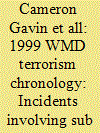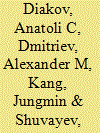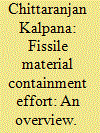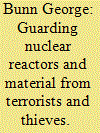| Srl | Item |
| 1 |
ID:
007147


|
|
|
|
|
| Publication |
Summer 2000.
|
| Description |
157-174
|
|
|
|
|
|
|
|
|
|
|
|
|
|
|
|
| 2 |
ID:
012984


|
|
|
|
|
| Publication |
June-Sept 1997.
|
| Description |
41-46
|
|
|
|
|
|
|
|
|
|
|
|
|
|
|
|
| 3 |
ID:
157474


|
|
|
|
|
| Summary/Abstract |
Terrorists could acquire nuclear weapons by using weapon-usable nuclear material that was stolen or otherwise diverted from legitimate authorities. Multiple well-documented seizures suggest the existence of a black market that draws on an unknown stock of weapon-usable nuclear material that is not under the control of authorities. We estimate the total amount of uncontrolled material based on publicly reported seizures and several different statistical methods and models. We estimate that 90 to 250 kilograms--sufficient for up to ten nuclear weapons--remain outside the control of legitimate authorities. While this estimate is subject to large uncertainties and potential bias, governments may have additional information about nuclear material seizures that could be used to improve estimates.
|
|
|
|
|
|
|
|
|
|
|
|
|
|
|
|
| 4 |
ID:
077015


|
|
|
|
|
| Publication |
2007.
|
| Summary/Abstract |
A considerable amount of experience has been accumulated in converting compact research reactors from highly-enriched uranium (HEU) to low-enriched uranium (LEU). Although the details of naval-reactor design are closely held military secrets, during the Gorbachev period, the Soviet Union supplied the Norwegian government with some basic data, including the dimensions and 235U content of the core of the HEU fueled KLT-40 reactor used in some Russian nuclear-powered icebreakers. A group of Norwegian analysts used this information to develop a simple model of the KLT-40 core. We have calculated the neutronics behaviors of variants of these core models as a function of 235U burnup and conclude that the reactors could be fueled with LEU without loss of core life. We also show that simplified infinite-core calculations can be used for such studies
|
|
|
|
|
|
|
|
|
|
|
|
|
|
|
|
| 5 |
ID:
012151


|
|
|
|
|
| Publication |
July 1997.
|
| Description |
623-633
|
|
|
|
|
|
|
|
|
|
|
|
|
|
|
|
| 6 |
ID:
020468


|
|
|
|
|
| Publication |
Oct 2001.
|
| Description |
8-12
|
|
|
|
|
|
|
|
|
|
|
|
|
|
|
|
| 7 |
ID:
059348


|
|
|
|
|
| Publication |
Sep-Oct 2004.
|
|
|
|
|
|
|
|
|
|
|
|
|
|
|
|
| 8 |
ID:
080684


|
|
|
|
|
| Publication |
2007.
|
| Summary/Abstract |
Since public disclosure by the Democratic People's Republic of Korea (DPRK) of its uranium enrichment program in 2002 and the subsequent restarting of its plutonium reactor, policymakers and academics have expressed concern that the DPRK will one day export nuclear material or components. An examination of North Korea's involvement in nonnuclear criminal activities shows that the DPRK has established sophisticated transnational smuggling networks, some of which involve terrorist groups and others that have been able to distribute counterfeit currency and goods on U.S. territory. These networks provide North Korea with a significant amount of much-needed hard currency, but the DPRK regime's control over them has decreased over time. These developments suggest that North Korea has both the means and motivation for exporting nuclear material, and that concerns over nuclear export from the DPRK, authorized or not, are well founded. When placed in the context of the global nuclear black market, the North Korea case suggests that criminal networks are likely to play an increased role in future proliferation. In addition, it raises the concern that proliferation conducted through illicit networks will not always be well controlled by the supplier state. It is therefore imperative to track and curtail illicit networks not only because of the costs they impose, but also because of the deterrent value of countersmuggling efforts. New strategies that integrate law enforcement, counterproliferation, and nonproliferation tools are likely to have the greatest success in addressing the risks posed by illicit proliferation networks
|
|
|
|
|
|
|
|
|
|
|
|
|
|
|
|
| 9 |
ID:
033651


|
|
|
|
|
| Publication |
London, Chapman & Hall Ltd, 1955.
|
| Description |
224p.
|
|
|
|
|
|
|
|
|
|
|
|
Copies: C:1/I:0,R:0,Q:0
Circulation
| Accession# | Call# | Current Location | Status | Policy | Location |
| 002339 | 621.483/HAU 002339 | Main | On Shelf | General | |
|
|
|
|
| 10 |
ID:
077013


|
|
|
|
|
| Publication |
2006.
|
| Summary/Abstract |
This article reviews the rationale of selecting an enrichment of just less than 20% (low-enriched uranium) as the preferred enrichment level for research reactor fuel in order to minimize overall proliferation risks. The net strategic value of the nuclear material associated with reactor operation is evaluated for a variety of enrichment levels, ranging from slightly enriched to weapon-grade fuel. To quantify the proliferation potential, both the demand of fresh uranium fuel as well as the plutonium buildup in the irradiated fuel are estimated via cell burnup calculations. The analysis confirms the usefulness of the current enrichment limit and challenges a recent trend to reconsider fuel enrichment levels between 20% and 50% for new research reactor projects
|
|
|
|
|
|
|
|
|
|
|
|
|
|
|
|
| 11 |
ID:
011276


|
|
|
|
|
| Publication |
March/April 1997.
|
| Description |
40-48
|
|
|
|
|
|
|
|
|
|
|
|
|
|
|
|
| 12 |
ID:
057399


|
|
|
| 13 |
ID:
007146


|
|
|
|
|
| Publication |
Summer 2000.
|
| Description |
146-156
|
|
|
|
|
|
|
|
|
|
|
|
|
|
|
|
| 14 |
ID:
099613


|
|
|
|
|
| Publication |
2010.
|
| Summary/Abstract |
There are several technical, institutional and geopolitical challenges facing an expanded nuclear industry in the twenty-first century. This article addresses some of the security concerns that are linked to the expansion of nuclear power in the world. Given that more and more states are going to have access to sensitive nuclear technology and material, the security concerns surrounding nuclear energy are bound to increase. However, in the absence of a satisfactory nuclear waste management solution and adequate regulatory protocols, a large-scale expansion of the civil nuclear sector will present significant security challenges. The adaptation of the fuel cycle to incorporate reprocessed spent nuclear fuel presents perhaps the most serious concern owing to the inherent relationship between reprocessing and nuclear proliferation. Of equal concern is the fact that existing international regimes are inadequate to deal with civilian nuclear-related issues in the twenty-first century.
|
|
|
|
|
|
|
|
|
|
|
|
|
|
|
|
| 15 |
ID:
022140


|
|
|
|
|
| Publication |
Aug 2002.
|
| Description |
30-32
|
|
|
|
|
|
|
|
|
|
|
|
|
|
|
|
| 16 |
ID:
139490


|
|
|
|
|
| Summary/Abstract |
The perpetuation of an otherwise astute fissile material safeguards model by the current non-proliferation regime raises a number of concerns, not least the efficacy of the approach in reducing clandestine weapon developments and the nuclear terrorism threat. Mindful of potential shifts in illicit nuclear material and weapon acquisition, following an excessive focus on fissile material safeguards and the proliferation of nuclear weapon technology, this article uses proliferation trend and scenario analysis in a bid to identify potential proliferation threats and non-proliferation opportunities. The results of the article's assessment of reported incidents (1992–2013) involving theft, unauthorised possession, and attempts to smuggle or sell highly enriched uranium (HEU), plutonium, low-enriched uranium (LEU), natural uranium and uranium yellowcake reveal a decline in occurrences involving fissile material but an increase in uranium yellowcake incidents, particularly in Africa. Presumptions that yellowcake may have provided the newest threat to clandestine weapon developments and nuclear terrorism wane amid concerns over possible biases in reporting, scepticism over an organised and demand-driven nuclear black market, and the difficulties of non-state actors’ development of crude nuclear weapons off the tedious yellowcake conversion-enrichment-fabrication pathway. To secure Africa's uranium yellowcake from potential proliferators, the article proposes concerted domestic, regional and multilateral non-proliferation efforts.
|
|
|
|
|
|
|
|
|
|
|
|
|
|
|
|